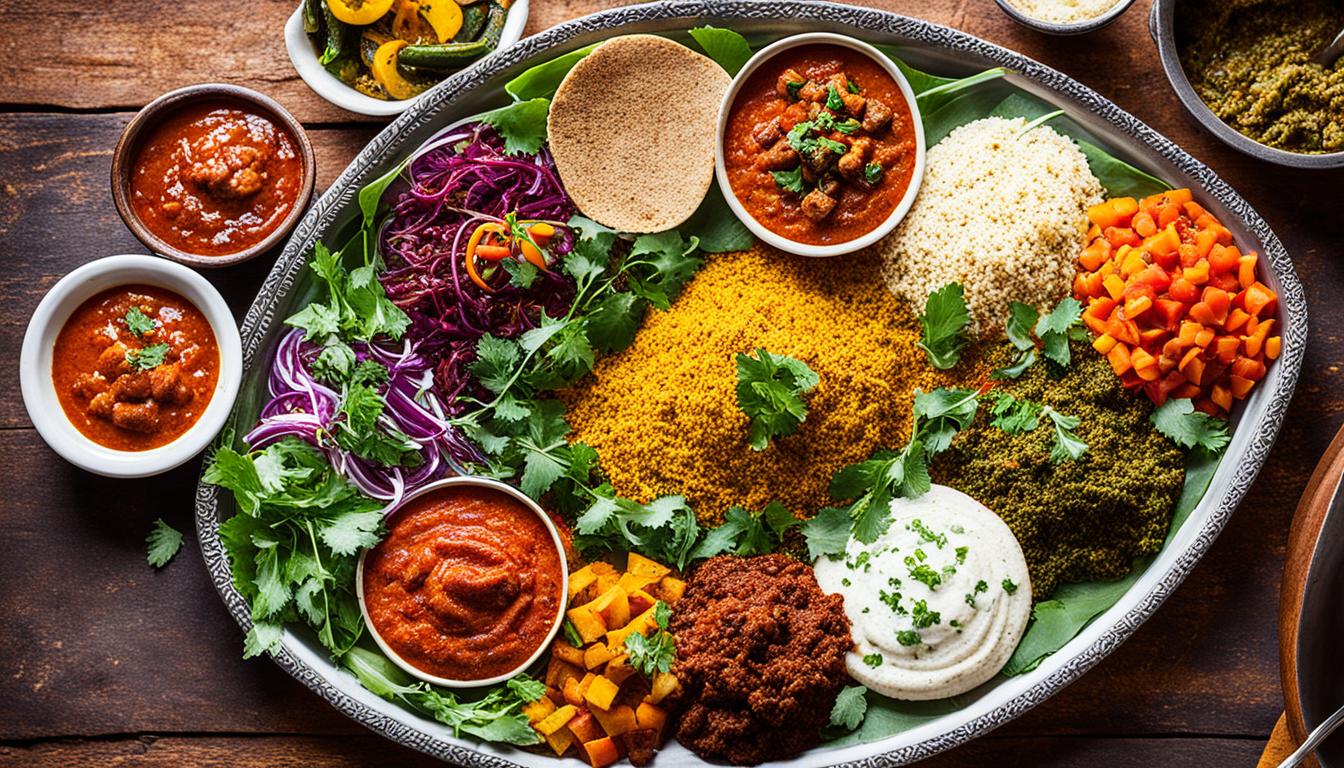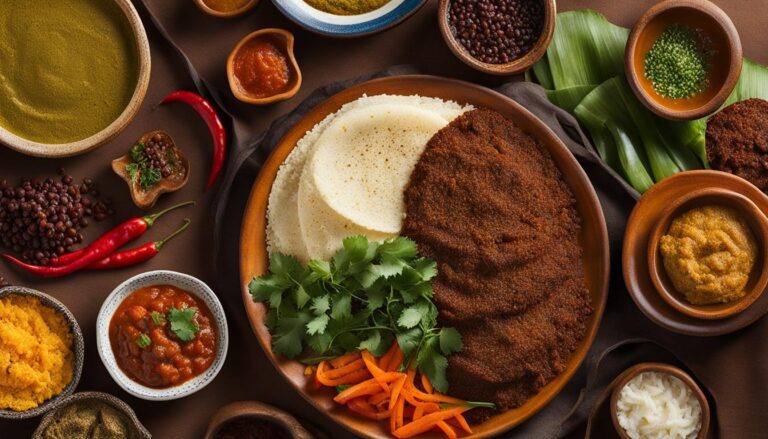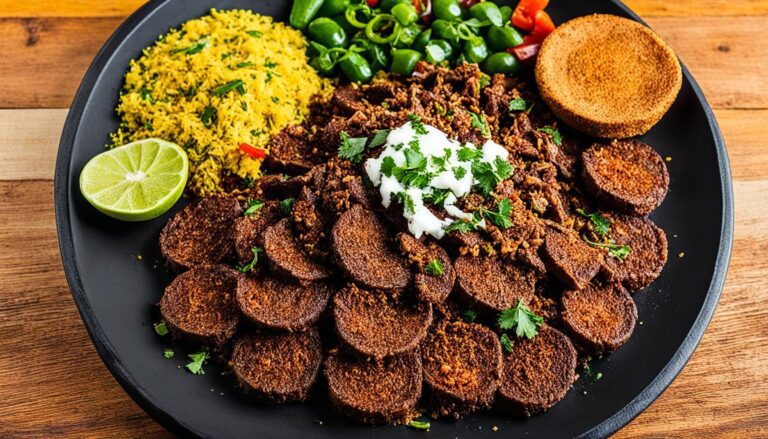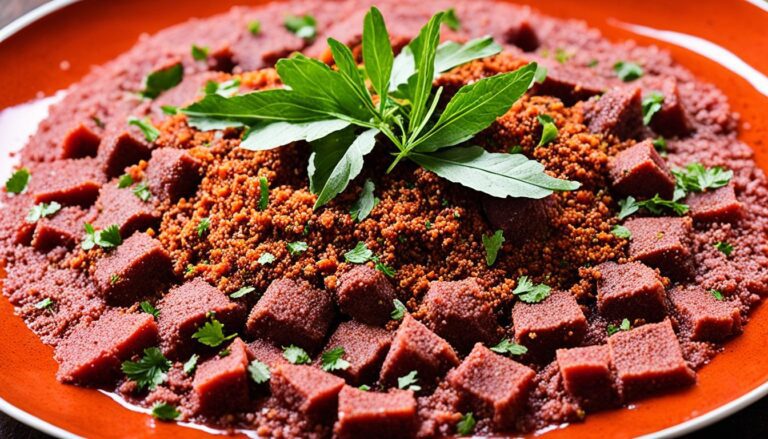Is Ethiopian Food African Food?
When we think of African cuisine, the vibrant flavors of dishes like jollof rice, braai, or fufu often come to mind. But where does Ethiopian food fit into this culinary tapestry? Is Ethiopian food truly African food? This question may challenge our preconceived notions about the diversity and complexity of African gastronomy.
Join us as we embark on a journey to explore the origins, ingredients, and cultural significance of Ethiopian cuisine. We’ll delve into the unique flavors and cooking techniques that define Ethiopian food, and examine its place within the broader context of African gastronomy. Prepare to have your taste buds tantalized and your perspectives challenged.
Key Takeaways:
- Ethiopian food raises questions about the definition and boundaries of African cuisine.
- Exploring the culinary heritage of Ethiopia helps us understand its unique flavors and cooking techniques.
- African gastronomy is a diverse tapestry of regional variations and influences.
- Examining the connections between Ethiopian cuisine and other African cuisines can shed light on its classification.
- Ethiopian food showcases its distinctiveness and cultural significance within the broader African culinary landscape.
Ethiopian Culinary Heritage
When it comes to Ethiopian cuisine, there is a rich and diverse culinary heritage that sets it apart from other African cuisines. The unique combination of ingredients, cooking techniques, and flavor profiles makes Ethiopian food truly distinctive.
At the heart of Ethiopian cuisine is injera, a sourdough flatbread that serves as the foundation of many traditional dishes. Made from fermented teff flour, injera is not only a staple food but also a cultural symbol of togetherness and communal dining.
One of the standout features of Ethiopian cooking is the use of spices and herbs. Berbere, a complex and flavorful spice blend made from chili peppers, garlic, ginger, and a variety of other spices, adds depth and heat to many Ethiopian dishes. Niter kibbeh, a spiced clarified butter, is another essential ingredient that enhances the unique taste of Ethiopian cuisine.
Vegetables such as lentils, cabbage, and carrots play a prominent role in Ethiopian dishes, providing a balance of flavors and textures. The combination of legumes, grains, and vegetables creates a diverse range of vegetarian and vegan options, making Ethiopian food particularly appealing to those following plant-based diets.
When it comes to meat dishes, Ethiopians have a preference for slow-cooked stews known as wats. These flavorful stews are typically made with chicken, beef, lamb, or goat and are often accompanied by spicy sauces and side dishes.
Understanding the distinctiveness of Ethiopian cuisine is crucial to evaluating its place within the broader category of African food. While Ethiopian food shares some similarities with other African cuisines, its unique flavors, cooking techniques, and cultural significance make it a true culinary gem.
African Gastronomy
In African gastronomy, diversity is at the heart of the vibrant food culture that spans the vast continent. Each region boasts its own unique ingredients, flavors, and cooking methods, contributing to the rich tapestry of African cuisine. From the aromatic spices of North Africa to the fiery chilies of West Africa, and the exotic flavors of East Africa to the indigenous ingredients of Southern Africa, the continent’s gastronomy showcases a remarkable range of culinary delights.
Africa’s diverse food culture is a reflection of its varied geography, history, and cultural influences. The continent’s cuisine is shaped by factors such as indigenous crops, trade routes, colonial legacies, and migration patterns. As a result, African gastronomy is a fusion of traditional practices and external influences, blending centuries-old traditions with global flavors.
The use of staple ingredients like millet, sorghum, maize, yams, plantains, and cassava forms the foundation of many African dishes. These ingredients are ingeniously transformed into a multitude of flavorsome meals through various cooking techniques such as grilling, stewing, frying, and steaming.
Across the continent, communal dining plays a significant role in African food culture. Sharing meals with family and friends emphasizes the social aspect of food, reinforcing the importance of community and hospitality. This tradition fosters a sense of togetherness and creates opportunities for cultural exchange.
African Cuisine: A Melting Pot of Culinary Diversity
The diverse food culture found across Africa is a testament to the continent’s culinary creativity and resourcefulness. African cuisine embodies the essence of African identity and offers a glimpse into the unique flavors and cooking traditions that define each region.
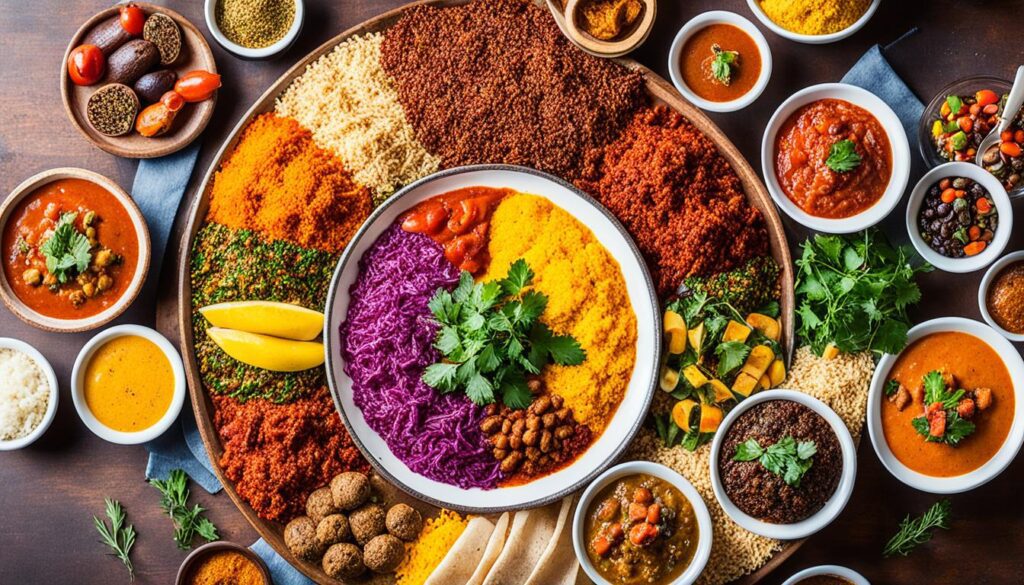
As we delve deeper into the African gastronomic landscape, we gain a greater understanding of the intricate tapestry of flavors, and appreciate the vast array of culinary experiences across the continent. Now that we have explored the broader context of African food, we can examine where Ethiopian cuisine fits into this diverse culinary spectrum.
Ethiopian Food in the African Context
When discussing the position of Ethiopian food within the larger African food context, it is essential to explore the shared culinary elements and influences between Ethiopian cuisine and other African cuisines. By examining these connections and overlaps, we can gain valuable insight into whether Ethiopian food can be classified as African food.
Ethiopian cuisine, with its bold flavors and unique cooking techniques, has both similarities and distinctiveness when compared to other African cuisines. One of the prominent shared elements is the use of indigenous ingredients that are abundant throughout the continent. Staples like grains, legumes, and vegetables are incorporated into various Ethiopian dishes, reflecting the African context in which they are prepared.
Moreover, Ethiopian food showcases influences from neighboring regions, such as North African and Middle Eastern cuisine. The flavorful spices and aromatic herbs used in Ethiopian dishes resonate with the broader African culinary heritage, connecting Ethiopian food with its African counterparts.
An example of this connection can be seen in the shared tradition of communal dining. In Ethiopia, it is common for friends and family to gather around a large shared platter, known as a “mesob,” and enjoy a communal meal together. This communal style of eating is not only a cultural practice in Ethiopia but also prevalent in various African countries, reinforcing the interconnectedness of Ethiopian food within an African context.
Influences on Ethiopian Cuisine
Ethiopian cuisine has also been influenced by historical trade and migration patterns. The country’s location on the eastern coast of Africa has facilitated cultural exchanges with Arabian and Indian merchants over centuries. The introduction of new spices, such as berbere and fenugreek, into Ethiopian cooking demonstrates the influences of these interactions.
Furthermore, the concept of injera, a sourdough flatbread made from teff flour, is a significant characteristic of Ethiopian cuisine. Injera plays a central role in Ethiopian food culture as it serves as a base for various dishes and is used to scoop up stews and sauces. Its uniqueness and importance within Ethiopian cuisine further contribute to its recognition as an integral part of the broader African culinary tapestry.
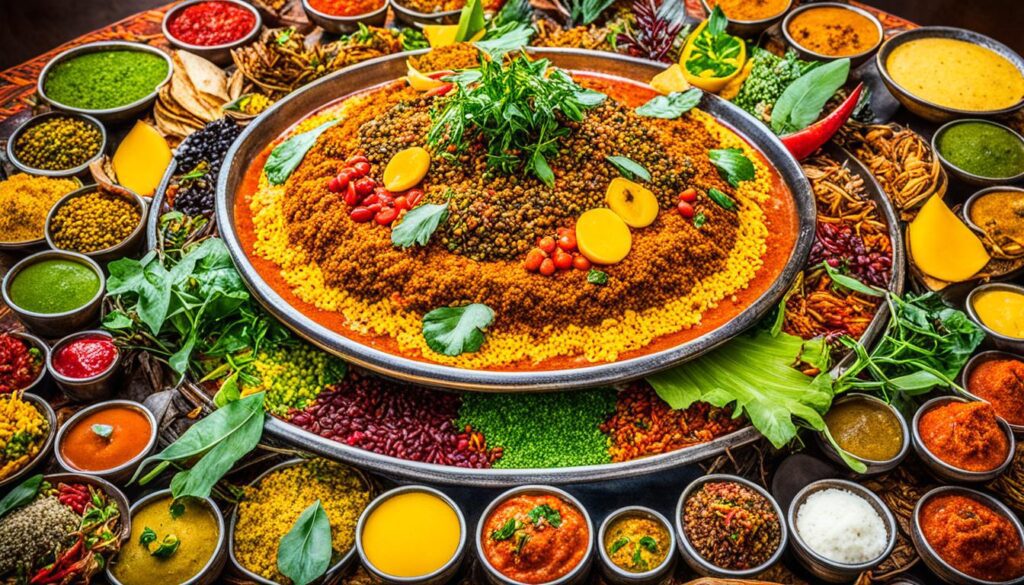
In conclusion, understanding the position of Ethiopian food within the African context requires a comprehensive examination of shared culinary elements, influences, and cultural practices. While Ethiopian cuisine may have distinctive flavors and cooking techniques, its connections to other African cuisines and the use of indigenous ingredients reinforce its place as an integral component of African food culture.
Ethiopian Food: A Unique Jewel
When it comes to culinary treasures, Ethiopian food stands out as a true gem in the African gastronomic landscape. With its distinctive flavors, unique ingredients, and rich cultural heritage, Ethiopian cuisine is a testament to the country’s rich history and diverse traditions.
One of the defining features of Ethiopian food is injera, a sourdough flatbread that serves as the foundation of many dishes. Made from fermented teff flour, injera is not only a delicious staple but also a symbol of Ethiopian identity and communal dining.
Another aspect that sets Ethiopian cuisine apart is the tradition of communal dining. Injera is often used as a shared plate, with various stews and dishes placed on top. This communal eating experience fosters a sense of togetherness and creates a unique social atmosphere around mealtime.
In addition to injera, Ethiopian food boasts a variety of flavors and spices that tantalize the taste buds. From the fiery berbere spice blend to the aromatic flavors of niter kibbeh (spiced clarified butter), each bite offers a burst of deliciousness.
Furthermore, Ethiopian cuisine showcases a harmonious blend of influences from Africa, the Middle East, and even Asia, making it a true melting pot of flavors and techniques. This fusion of culinary traditions is a testament to Ethiopia’s historical role as a crossroads of cultures.
Whether it’s the elaborate process of making traditional dishes or the vibrant, aromatic spices used in their preparation, Ethiopian food is indeed a unique jewel within the African culinary realm. Its exceptional characteristics and deep-rooted cultural significance make it a destination for food lovers seeking a memorable and enriching culinary experience.
Conclusion
In conclusion, our exploration of Ethiopian food and its place within the African culinary landscape has revealed its unique position as a jewel in African gastronomy. While Ethiopian food shares some similarities with other African cuisines, its distinct flavors, techniques, and cultural significance set it apart as a culinary gem.
During our journey, we delved into the rich culinary heritage of Ethiopia, uncovering the unique ingredients, cooking techniques, and flavor profiles that define Ethiopian cuisine. We also took a broader look at the diverse food culture found across the African continent, highlighting the regional variations in ingredients, flavors, and cooking methods that make African gastronomy so captivating.
Through our exploration, it became evident that Ethiopian food occupies a special place within the African context. While influenced by neighboring countries, it has developed its own distinctive character. The importance of injera, a sourdough flatbread, and the tradition of communal dining further exemplify the defining features of Ethiopian food.
In essence, Ethiopian food can be considered African food, albeit with its own unique identity. By celebrating the distinct flavors, techniques, and cultural significance of Ethiopian cuisine, we honor its contribution to the tapestry of African gastronomy.

